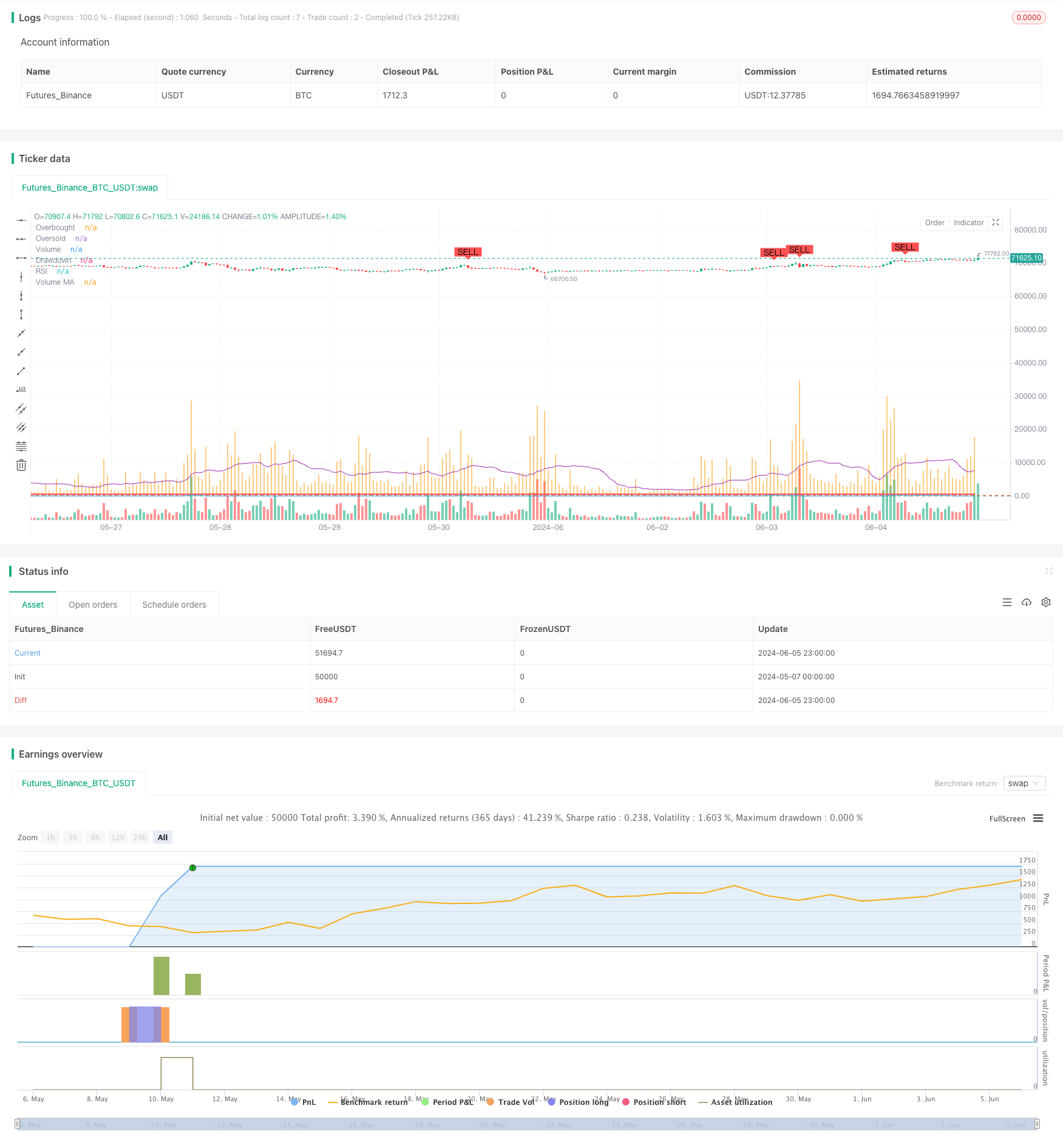RSI 다이내믹 드라다운 스톱 로스 전략
저자:차오장, 날짜: 2024-06-07 15:47:51태그:RSIMA

전반적인 설명
이 전략은 와이코프 방법론에 기초하고 있으며, 상대 강도 지수 (RSI) 와 볼륨 이동 평균 (Volume MA) 를 결합하여 시장의 축적 및 유통 단계를 식별하여 구매 및 판매 신호를 생성합니다. 또한 전략은 최대 유출 한계치를 설정하여 위험을 제어하기 위해 동적 인 유출 중지 손실 메커니즘을 사용합니다.
전략 원칙
- RSI 지표와 볼륨 이동 평균을 계산합니다.
- RSI가 과잉 판매 부위를 넘어서서 부피가 부피 MA보다 크면 시장의 축적 단계를 식별하고 구매 신호를 생성합니다.
- RSI가 과잉 매수 영역 아래를 넘어서서 부피가 부피 MA보다 크면 시장의 분포 단계를 식별하고 판매 신호를 생성합니다.
- 이 전략은 동시에 계좌의 최대 자금과 현재 유출을 추적합니다. 현재 유출이 설정된 최대 유출 한계를 초과하면 전략은 모든 포지션을 닫습니다.
- 매수 포지션은 분배 단계 또는 마감이 최대 마감을 초과할 때 닫히고 매수 포지션은 축적 단계 또는 마감이 최대 마감을 초과할 때 닫힌다.
전략적 장점
- RSI와 부피 지표를 결합함으로써 전략은 시장의 축적 및 유통 단계를 더 정확하게 포착 할 수 있습니다.
- 동적 마감 스톱 로스 메커니즘은 전략의 최대 마감을 효과적으로 제어하여 전체 전략 위험을 줄입니다.
- 5분 동안의 고주파 데이터에 적합하며 시장 변화에 신속한 반응과 적시에 위치 조정이 가능합니다.
전략 위험
- RSI 및 부피 지표는 특정 시장 조건에서 잘못된 신호를 생성하여 전략의 잘못된 거래 결정으로 이어질 수 있습니다.
- 최대 유출 기준값의 설정은 시장 특성과 개인의 위험 선호도에 따라 조정되어야 합니다. 부적절한 설정은 조기 포지션 종료 또는 과도한 위험 취득으로 이어질 수 있습니다.
- 이 전략은 불안정한 시장에서 빈번한 거래 신호를 생성하여 거래 비용을 증가시킬 수 있습니다.
전략 최적화 방향
- 전략의 신호의 정확성을 향상시키기 위해 MACD, 볼링거 밴드 등과 같은 다른 기술 지표를 도입하는 것을 고려하십시오.
- 다른 시장 조건에 적응하기 위해 RSI 및 부피 지표의 매개 변수를 최적화합니다. 예를 들어 RSI의 길이를 조정하고, 과소 구매/ 과소 판매 기준 등을 조정합니다.
- 마감 스톱-러스 이외에도 후속 스톱-러스 또는 이익 보호 메커니즘을 포함하여 위험을 더 통제하고 이익을 고정하십시오.
요약
RSI 동적 인하 스톱-손실 전략은 리스크를 제어하기 위해 동적 인하 스톱-손실 메커니즘을 사용하는 동시에 RSI 및 볼륨 지표를 결합하여 시장의 축적 및 분배 단계를 식별합니다. 전략은 시장 추세와 리스크 관리 모두를 고려하여 어느 정도 실용화됩니다. 그러나 전략의 성능은 지표 매개 변수와 시장 특성에 따라 선택되며 안정성과 수익성을 향상시키기 위해 지속적인 최적화와 조정이 필요합니다.
/*backtest
start: 2024-05-07 00:00:00
end: 2024-06-06 00:00:00
period: 1h
basePeriod: 15m
exchanges: [{"eid":"Futures_Binance","currency":"BTC_USDT"}]
*/
//@version=5
strategy("Wyckoff Methodology Strategy with Max Drawdown", overlay=true)
// Define input parameters
length = input(14, title="RSI Length")
overbought = input(70, title="RSI Overbought Level")
oversold = input(30, title="RSI Oversold Level")
volume_length = input(20, title="Volume MA Length")
initial_capital = input(10000, title="Initial Capital")
max_drawdown = input(500, title="Max Drawdown")
// Calculate RSI
rsi = ta.rsi(close, length)
// Calculate Volume Moving Average
vol_ma = ta.sma(volume, volume_length)
// Identify Accumulation Phase
accumulation = ta.crossover(rsi, oversold) and volume > vol_ma
// Identify Distribution Phase
distribution = ta.crossunder(rsi, overbought) and volume > vol_ma
// Plot RSI
hline(overbought, "Overbought", color=color.red)
hline(oversold, "Oversold", color=color.green)
plot(rsi, title="RSI", color=color.blue)
// Plot Volume and Volume Moving Average
plot(volume, title="Volume", color=color.orange, style=plot.style_histogram)
plot(vol_ma, title="Volume MA", color=color.purple)
// Variables to track drawdown
var float max_equity = initial_capital
var float drawdown = 0.0
// Update max equity and drawdown
current_equity = strategy.equity
if (current_equity > max_equity)
max_equity := current_equity
drawdown := max_equity - current_equity
// Generate Buy and Sell Signals
if (accumulation and drawdown < max_drawdown)
strategy.entry("Buy", strategy.long)
if (distribution and drawdown < max_drawdown)
strategy.entry("Sell", strategy.short)
// Plot Buy and Sell signals on chart
plotshape(series=accumulation, location=location.belowbar, color=color.green, style=shape.labelup, title="Buy Signal", text="BUY")
plotshape(series=distribution, location=location.abovebar, color=color.red, style=shape.labeldown, title="Sell Signal", text="SELL")
// Close positions if drawdown exceeds max drawdown
if (drawdown >= max_drawdown)
strategy.close_all("Max Drawdown Exceeded")
// Set strategy exit conditions
strategy.close("Buy", when=distribution or drawdown >= max_drawdown)
strategy.close("Sell", when=accumulation or drawdown >= max_drawdown)
// Display drawdown on chart
plot(drawdown, title="Drawdown", color=color.red, linewidth=2, style=plot.style_stepline)
관련
- 다중 확증 반구 구매 전략
- 가장 좋은 트레이딩 뷰 전략
- 고급 동적 피보나치 리트레이싱 트렌드 양적 거래 전략
- MA, SMA, MA 슬로프, 트래일링 스톱 손실, 재입구
- 동적 RSI 오버셀드 리바운드 트레이딩 전략
- 볼링거 밴드, 이동 평균 및 RSI를 기반으로 한 단기 거래 전략
- EMA와 트렌드 라인 브레이크에 기초한 이중 이동 평균 RSI 모멘텀 전략
- RSI-ATR 모멘텀 변동성 결합 거래 전략
- 여러 기간 이동 평균 및 RSI 모멘텀 크로스 전략
- 토요일 전환 전략 (주말 필터)
더 많은
- BB 탈출 전략
- VWAP 및 RSI 동적 볼링거 밴드 수익 및 중단 손실 전략
데-크롤 정지 동적 ATR 트렌드 전략 - 이 전략은 Chaikin 화폐 흐름 (CMF) 에 기반한 거래 신호를 생성합니다.
- 트렌드 필터링 핀 바 역전 전략
- 지원 및 저항 수준에서 반전 패턴에 기초한 양적 거래 전략
- MA, SMA, MA 슬로프, 트래일링 스톱 손실, 재입구
- 횡단 전략
- EMA의 이중 이동평균 크로스오버 전략
- Williams %R 동적 TP/SL 조정 전략
- 부피 변칙 탐지 기능이 있는 VWAP 거래 전략
- 슈퍼트렌드와 EMA 결합 전략
- TGT 가격 하락에 기반한 구매 전략
- EMA 크로스오버와 RSI 필터와 함께 듀얼 트렌드 전략
- EMA와 Parabolic SAR 결합 전략
- MACD 및 RSI 다중 필터 내일 거래 전략
- 두 시장 사이의 가격 관계 기반의 중재 거래 전략
- RSI 기반의 거래 전략, 수익을 취하고 손실을 중지하는 비율
- 최적화 된 장기 거래를 위한 MACD 및 마틴게일 조합 전략
- 엘리엇 웨브 스토카스틱 EMA 전략